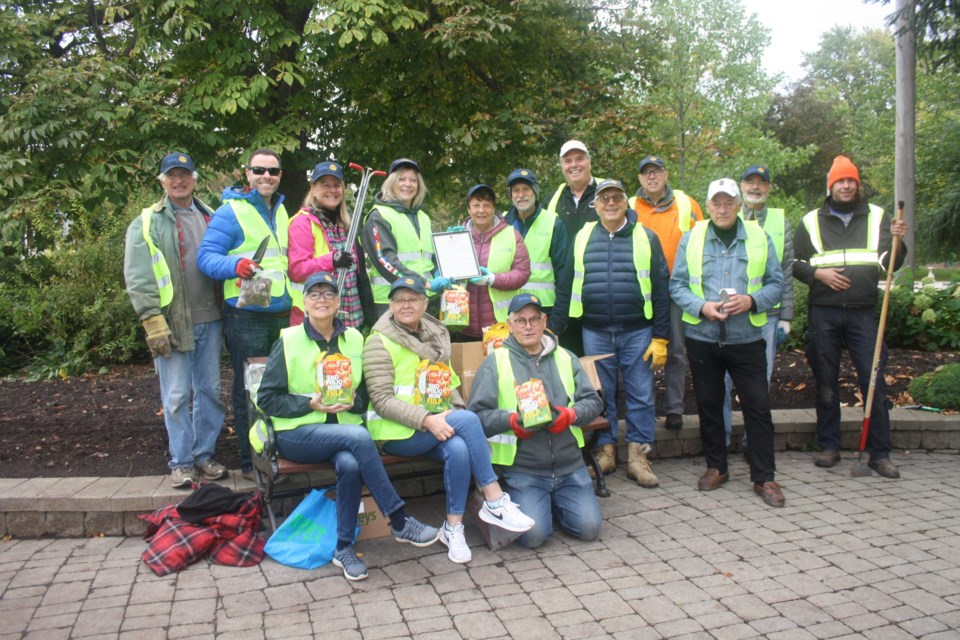Rotarians have been committed to preventing polio paralysis in children around the world for more than 30 years.
They’re close, but won’t stop any time soon.
Members of the NOTL Rotary Club gathered in their bright yellow vests at Simcoe Park early Friday morning to plant 600 tulip bulbs as part of their commitment to eradicate polio.
Working with town staff on the cool fall day — perfect for planting — they’ve chosen one of the most visible locations in Niagara-on-the-Lake to plant End Polio Now tulips, specifically bred for that cause. Their goal is for the red and yellow blooms to brighten up the corner and attract the attention of visitors and locals passing by next spring.
There will be a plaque in the tulip beds, says NOTL Rotary Club president Patricia Murenbeeld, to explain the presence of those particular bulbs and bring awareness to the reason for planting them.
Since 1988, Rotary clubs around the world have raised $1.2 billion, with more than 20 million volunteers contributing to the vaccination of almost three billion children. As a founding partner of the Global Polio Eradication Initiative, Rotary has reduced polio cases by 99.9 per cent since the first project to vaccinate children in the Philippines.
They are close to reaching their goal, but won’t stop until children in Afghanistan and Pakistan, where polio remains endemic, are also vaccinated. And even then, says Rotary member Jolanta Janny, they will continue their vaccination initiative to keep all countries polio-free.
The End Polio Now Tulips were developed in the Netherlands especially to raise money and awareness of the continuing need for polio eradication.
With town staff set to help out, Rotarians timed the planting close to World Polio Day, Oct. 24, which was established by Rotary International to raise awareness for polio vaccination and eradication of polio and commemorate the birth of Jonas Salk, who led the first team to develop the vaccine.
For the first time, says Murenbeeld with pride, Lord Mayor Betty Disero, also a Rotary member, has proclaimed Oct. 24 World Polio Day in NOTL.
Janny, one of the organizers of the planting, says if the town “graciously allows us to continue next year,” she hopes to expand the fundraiser by selling tulips to NOTL residents. “My vision is to see these red and yellow tulips all around town, and to raise more money for polio eradication.”
The End Polio Now tulip was developed in 2013 by Dutch grower Jan Lichthart, and has spread world-wide since. For each $25 box Rotary International purchases, a donation of $13 is made to polio eradication, and with two-to-one matching funds by the Gates Foundation, the end result becomes triple the initial contribution.
Murenbeeld, of Dutch ancestry herself, recounts the story of her mother in the Netherlands, who lived near a tulip field, and was one of many who survived what is referred to as the Winter of Hunger, shortly before the liberation of the country in 1945, by eating tulip bulbs. Murenbeeld is also a former resident of Ottawa, which holds an annual tulip festival featuring bulbs received by Queen Juliana as a gift to recognize the Canadian liberation of the Netherlands in the Second World War. To her, the powerful significance of tulips makes the planting in Simcoe Park a perfect way to raise awareness and funds for the Rotary cause, she says.
Dylan Muileboom, the town parks and recreation lead hand, was at Simcoe Park to give a quick lesson on the basics of planting tulip bulbs. He had already ensured the beds were prepared for planting, and in the next couple of weeks, he and his crew will be doing the same for the rest of the Queen Street beds.
They will plant about 12,500 tulip bulbs this fall to create a beautiful spring show of colour, to be pulled up to be replaced by annuals for the summer.
Muileboom, who designs the beds for planting, says he ensures those within eye sight of Simcoe Park will be yellow, red and maybe some orange, so they compliment the 600 bulbs the Rotarians have planted.
“We’re using the beds as a starting point,” he says. “We’ll be starting to plant the rest in about two weeks’ time.”
And when they bloom in the spring, those colourful flower beds at the entrance will Simcoe Park will be a reminder that the Rotary commitment to eradicating polio is ongoing, through the generosity of members and all who support them.
Aiden O’Leary, the polio eradication director for the World Health Organization, says he understands the difference Rotary can make in the global fight against polio. Although the goal is close, there is no room for complacency, he says. “What is really important is that we double down on reaching the persistently missed children who are a top priority for our program.”
The message, he says, is simple: “A polio-free world is within reach. There is an opportunity, and now is the time to stay the course.”
For more information or to donate, visit niagaraonthelakerotary.ca.
